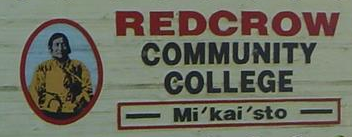Common Gaillardia – Gaillardia aristata Pursh (Brown eyed Susan, Blanket Flower)
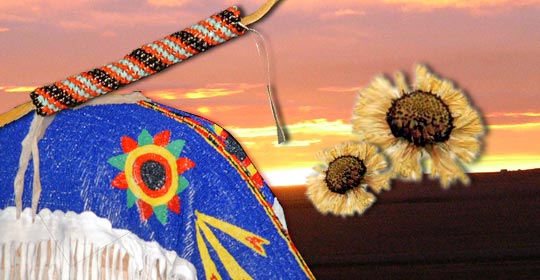
The Common Gaillardia is a popular decoration for clothing and beadwork.
(Glenbow Museum. (2005). Nitsitapiisinni Exhibit. Calgary, Alberta: Blackfoot Gallery Committee.)
Amo ni’nsimaan iikaipisspssaisski. Iitowapistisskitsi mo aksiksitokahki Niipomahkatoyiikistsikaato’si ki Pakkii’pistsiotsitai’tspi ki iitao’tssaisskiiyaw mohsokoitsi.
Iikohtowakaomiaanistsisitapiyo’p amo ni’nsimaan. Ihtaohpoonohso’p, ihtaikistsikimisstao’p,ihpaissiikawatso’p,ihtaohpooni’p kotokiaanokoisskinitsima’tsiistsi mahkohtssowai’piistsipia, ki matohtaikotskiiksistsikimistaa omahkitapiiksi ihtapiinomoyiiyaw ponokaomitaiksi.
Common Gaillardia
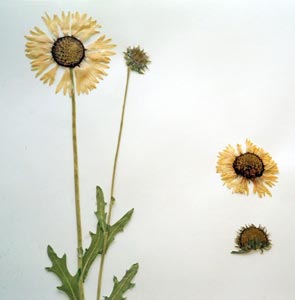
Gaillardia aristata Pursh
Galileo Educational Network
Common Gaillardia is a tall plant with hairy, greyish green leaves that are longer at the bottom, then get smaller as they get closer to the flower. This plant with its large (10 cm) yellow flowers is also called the Brown-eyed Susan because of its brown center. It blooms in the late summer months of July and August, growing along the roads and railway tracks and in dry, upland areas.
There are uses for almost every part of the Common Gaillardia. A dressing made of mashed, powdered roots can be smeared on skin conditions, while a tea made of the plant can be used as an eyewash, as nosedrops or rubbed on a nursing mother’s sore nipples. Tea made of the root works for curing stomach troubles. A tea made of heads of the flowers can be used as a footwash.
The elders used the large flower heads of the Brown-eyed Susan in creative ways. They were used to absorb the grease off soups and broth, and as spoons for serving food to sick people. The heads of the flowers were rubbed on rawhide bags for waterproofing from the rain and snow and to keep things dry inside. The elders would rub strong medicine teas made from the roots on their horses’ saddle sores and places where the hair was falling out. It was also used in their horses’ eyes as an eyewash.
Gaillarde vivace
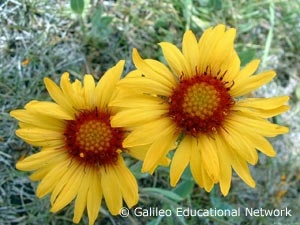
Gaillardia aristata Pursh
Galileo Educational Network
La gaillarde vivace est une plante élancée ayant des feuilles velues de couleur verdegris. Les feuilles du bas sont plus larges. Plus elles sont proches des fleurs, plus elles sont petites. Cette plante aux grosses fleurs jaunes (10 centimètres) s’appelle aussi marguerite jaune. Elle fleurit aux mois de juillet et d’août. Elle pousse le long des voies ferrées et des routes, de même que dans les hautes terres sèches.
Presque toutes les parties de la gaillarde vivace servent à quelque chose. Un pansement composé de racines écrasées et en poudre peut être étalé sur des plaies, tandis qu’un thé fabriqué à partir de cette plante peut servir de gouttes pour nettoyer les yeux ou de gouttes pour le nez. Ce thé peut aussi être appliqué sur les mamelons sensibles des femmes qui allaitent. Le thé fait à partir des racines de la gaillarde vivace permet de guérir les maux d’estomac, tandis que le thé fait avec les boutons de fleurs peuvent servir à nettoyer les pieds.
Nos aînés se servaient des gros boutons de fleurs de la gaillarde de manière créative. Les boutons absorbaient la graisse des soupes et des bouillons ou encore, ils servaient de cuillère pour faire manger la nourriture aux malades. Aussi, ils frottaient les boutons de cette fleur sur des sacs en peau afin de les rendre à l’épreuve de la pluie et de la neige, ce qui permettait de garder le contenu de ces sacs au sec. Les aînés frottaient des thés forts faits à partir des racines de cette plante sur les maux de garrot de leurs chevaux ainsi que sur les endroits où les poils tombaient. Ces thés permettaient aussi de laver les yeux des chevaux.
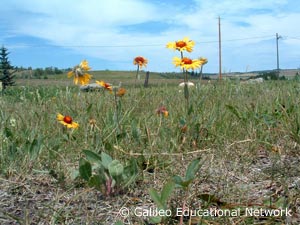
Gaillardia aristata Pursh
Galileo Educational Network
- Hellson, John C. (1974). Ethnobotany of the Blackfoot Indians. Ottawa: National Museums of Canada.
- Moerman, Daniel E. (1998). Native American Ethnobotany. Portland: Timber Press.
- Sedivec,K.K & Barker, W.T. (1998) Selected North Dakota and Minnesota Range Plants. North Dakota: North Dakota State University. http://www.ag.ndsu.nodak.edu/ Retrived: February 12, 2005 http://www.ext.nodak.edu/extpubs/ansci/range/eb69-12.htm
- Vance, F.R., Jowsley, J.R. & Mclean, J.S. (1984). Wildflowers Across The Prairies. Saskatoon, Saskatchewan: Western Producer Prairie Books.
- Willard, Terry. (1992). Edible and Medicinal Plants of the Rocky Mountains and Neighboring Territories. Calgary, Alberta: Wildrose College of Natural Healing.



